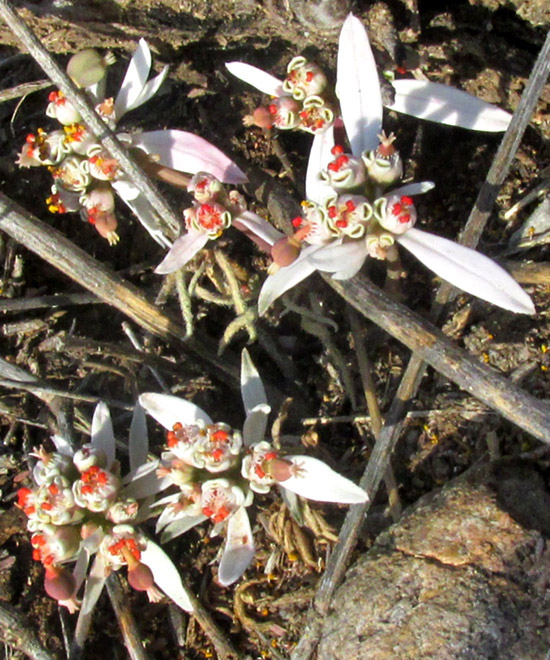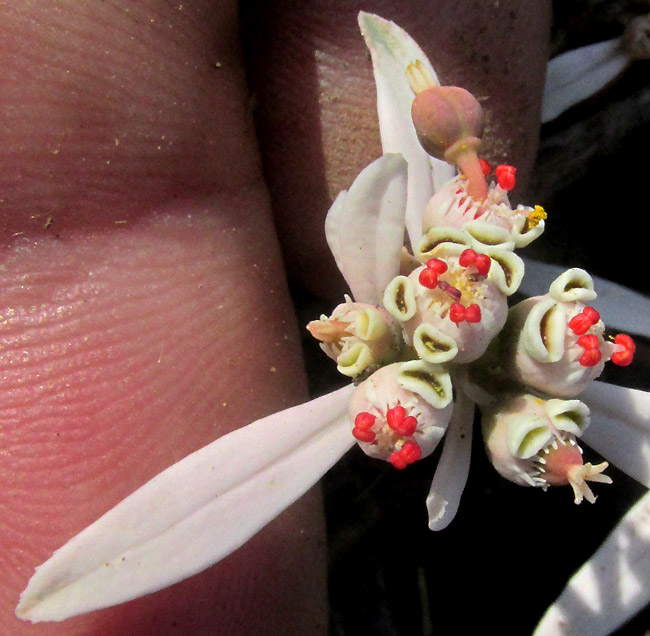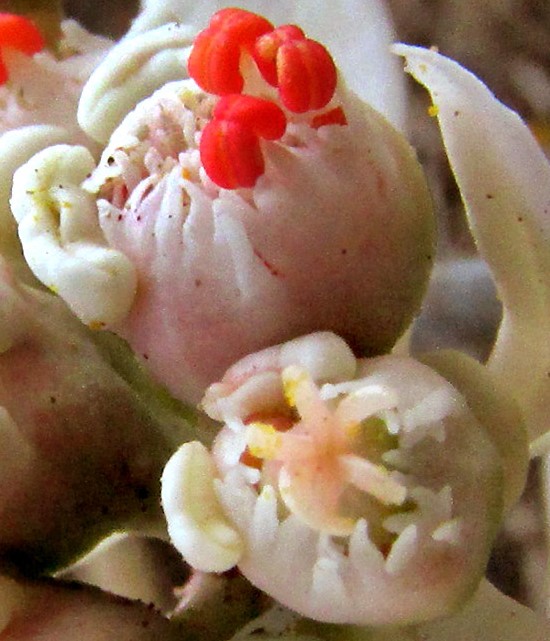Excerpts from Jim Conrad's
Naturalist Newsletter
Entry dated February 17, 2024, issued from near Tequisquiapan; elevation about 1,900m, (6200 ft), ~N20.57°, ~W99.89°; Querétaro state, MÉXICO
SUN SPURGE

To fully appreciate the above, you should visualize the large abandoned, scrubby area they lived in. Once the land must have been a savanna with widely spaced tree cacti, mesquites and acacias, and grasses and wildflowers in their season. But centuries of ranching, traditional burning and firewood gathering with attendant soil compaction and erosion left a landscape of sandy dirt strewn with dark-pink volcanic rocks and a few knee-high, spiny mimosas. During the rainy season it can be green with small clumpgrasses and herbs, but now it was the heart of the usual dry season, during an ongoing two-year period categorized by the North American Drought Monitor as a D3 Extreme Drought; everything here was hues of parched gray and brown. The little cluster of sprouts was only the size of an apple, but its sun-burst patterns of pure white brilliance stood out like sparklers on Christmas night.

Above, the white, tongue-shaped item extended above my finger, which helps judge the dimensions of things, is a leaf. The plant issues short stems, atop which a few white flowers appear, immediately subtended by even fewer white leaves. Up close, it's clear that with mature ovaries -- as seen at the picture's top, right corner -- on short stems curving outward from within a special kind of cup-like involucre known as a cyathium, and from within the cyathium there being one or more male flowers consisting of only one stamen, this had to be yet another species of the genus Euphorbia.
Euphorbia is one of the two or three most species-rich flowering-plant genera worldwide. Among the many species I've seen, this was my first one with white leaves and cyathia. Above, the maturing ovaries are pale raspberry color, topped with three white, deeply forked styles, and the stamens' anthers are pale red.

Occupying the top half of the above picture, a cyathium has on its right size reddish anthers emerging from atop white filaments. The cyathium's rim is fringed with in-curving teeth. Attached to the cyathium's left, outer side there are two items shaped like cauliflower ears. These are closed nectar glands. In the previous picture of more mature flowers, the glands are open.

Above the grape-colored ovary is better seen extending from its cyathium. I'm guessing that the many smaller, upward projecting, fingerlike items around the ovary's stalk are stamen filaments lacking anthers. In the literature I find no mention of such a detail, though the Flora of North America reports 20-25 stamen-bearing male flowers in each cyathium for this species.
The Flora fanerogámica del Valle de México, which probably documents 99% of the flowering plants for this extreme southern part of mountainous Querétaro state, lists 24 Euphorbia species. Of those 24 species, with our plant's deep, ear-like glands on the cyathias' sides, and with only a few white leaves present during the flowering period, our plant easily reveals itself as EUPHORBIA RADIANS. In English sometimes the species is known as Sun Spurge.
Sun Spurge is widely distributed but scattered from the US's arid mountains along the Mexican border in New Mexico and Texas, south through the Mexican uplands to Oaxaca. In the US it's described as living in pinyon-juniper woodlands, oak savannas, desert grasslands and scrub. In this part of highland central Mexico, it's said to be scarce in open places, especially grasslands and eroded fields, and even as a weed in disturbed areas, sometimes abundant.
In 2020 Jaime Rivera and others published "The Great Euphorbia radians Benth." They didn't really explain why it's so great, but did recognize the above features, which are great enough. They reported that the species was first scientifically collected in 1837 in Guanajuato state by the German botanist Karl Theodor Hartweg. They also provide a picture of the species' potato-like tuberous root, the deeply buried tuber about the size of the whole cluster of flowering sprouts. Each sprout's slender stem continues into the ground where it thickens and becomes kinky, corky and somewhat nodular. Three such sprouts are seen emerging from the tuber's top. The top sprouts die back each year, while the tuber lives on.
One wonders how a plant with so few small, slender leaves which are white can photosynthesize enough carbohydrates to create such large tubers. Some pictures of the species show white leaves tinged with raspberry pinkness, so it's clear that the leaves can possess pigments, and photosynthesis must be going on in there someplace. Still, how many seasons must it take to produces such large tubers?
The authors of "The Great Euphorbia radians Benth." record that the tender tuber is reported as edible, as well as the inflorescences. On the other hand, the online magazine "El Charco del Ingenio," of the botanical garden of San Miguel de Allende, Guanajuato, Mexico, reports the species as toxic, even as it's used medicinally to treat kidney infections.